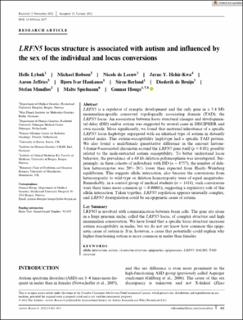LRFN5 locus structure is associated with autism and influenced by the sex of the individual and locus conversions
Lybæk, Helle; Robson, Michael; de Leeuw, Nicole; Hehir-Kwa, Jayne Y.; Jeffries, Aaron; Haukanes, Bjørn Ivar; Berland, Siren; de Bruijn, Diederik; Mundlos, Stefan; Spielmann, Malte; Houge, Gunnar Douzgos
Journal article, Peer reviewed
Published version

Åpne
Permanent lenke
https://hdl.handle.net/11250/3012000Utgivelsesdato
2022Metadata
Vis full innførselSamlinger
- Department of Clinical Science [2379]
- Registrations from Cristin [10237]
Sammendrag
LRFN5 is a regulator of synaptic development and the only gene in a 5.4 Mb mammalian-specific conserved topologically associating domain (TAD); the LRFN5 locus. An association between locus structural changes and developmental delay (DD) and/or autism was suggested by several cases in DECIPHER and own records. More significantly, we found that maternal inheritance of a specific LRFN5 locus haplotype segregated with an identical type of autism in distantly related males. This autism-susceptibility haplotype had a specific TAD pattern. We also found a male/female quantitative difference in the amount histone-3-lysine-9-associated chromatin around the LRFN5 gene itself (p < 0.01), possibly related to the male-restricted autism susceptibility. To better understand locus behavior, the prevalence of a 60 kb deletion polymorphism was investigated. Surprisingly, in three cohorts of individuals with DD (n = 8757), the number of deletion heterozygotes was 20%–26% lower than expected from Hardy–Weinberg equilibrium. This suggests allelic interaction, also because the conversions from heterozygosity to wild-type or deletion homozygosity were of equal magnitudes. Remarkably, in a control group of medical students (n = 1416), such conversions were three times more common (p = 0.00001), suggesting a regulatory role of this allelic interaction. Taken together, LRFN5 regulation appears unusually complex, and LRFN5 dysregulation could be an epigenetic cause of autism.
